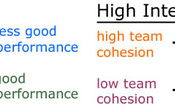Home advantage and Team Cohesion
Edited by Jamie (ScienceAid Editor), Taylor (ScienceAid Editor)
Home Ground Advantage
Home ground advantage is defined as: the constant finding that home teams in sports competitions win over 50% of the games played under a balanced home and away schedule.
Here are some factors that cause "home ground advantage".
- 1We start off with the most important factor of them all. A home crowd is more supportive of the home team, there is also a greater density and volume of audience.Audience.Advertisement
- 2Officials.They tend to favour the home side because of the pressure from the crowd Nevill et all (1999).
- 3The players on the "visiting team" are more likely to break the rules due to fatigue and pressure from the audience. This favours the home team because the visiting team is likely to be penalized more often by breaking the rules.Rules.
- 4The home team spends more time at the home ground so know more about the specific structure stadium, field, etc. They are in familiar territory. Also, they are less likely to be distracted by their surroundings compared to the visiting team who are distracted by the new surroundings and will lose some of their concentration.Familiarity.
However, sometimes being at home is a disadvantage. This is an affect known as championship choke. It was based on archival and historical research by Baumeister et. al., looking at the basketball world series. They found that in the last games of the championship, the home team won the minority of games at home. Below is a laboratory study by Butler & Baumeister into this.
| Aim | Investigate the affects of different types of audience on performance to discover under which conditions the championship choke may and may not occur. |
| Method | Participants were asked to complete a difficult maths problem (counting backwards in 13s from 999). Half of the participants were told they were being observed (via a one-way mirror) by a stranger and the other half told they were being observed by a friend. |
| Results | Participants who thought they were being observed by a stranger completed more subtractions correctly than participants who thought they were being observed by a friend. |
| Conclusion | Even though the audience could not be seen, a friendly and presumably supportive audience negatively affected performance. |
| Evaluation | This experiment cannot be compared to a team-sports setting; because it was a mental-arithmetic task carried out individually |
Team Cohesion
Team cohesion is a tendency for a group to stick together and remain united in the pursuit of common goals. It can be divided into two types.
- 1An example of this would be going to the pub together after training, or conversely a team who rarely talked to each other.Social Cohesion is how well a team get along with each other personally.
- 2This is the extent to which members of the team work together.Task Cohesion.
Team cohesion is affected by various factors, including:
- 1If a sport is unusual (like Baseball in the UK or netball in US) then there will be few people who want to play, you'd have to travel quite a distance to get to the facilities, and it would be difficult to find teams to play against.Popularity.
- 2This word means 'all being the same'. If the team members are similar in terms of social background, attitudes, ability, commitment and personality; then there will be better cohesion.'Homogeneity [ho-mo-jen-ay-ih-ti].
- 3The captains and leaders of teams should be constant. The players must agree with and respect the leader.Leadership.
- 4Larger teams have been found to have lower cohesion, this is because a larger team is more likely to divide into sub-groups.Team size.
All of this theory may be slightly useful for team captains, but now we look at the one thing that all teams strive for: success!. Does good team cohesion lead to success, and does success lead to cohesion? Martens and Peterson (1971) proposed a circular model to show how success, satisfaction and performance relate.
There is no real reason why the arrows should go that way round; they could just as easily go in the other direction as well. The two studies below provides evidence for these two views.
| Study | Slater & Sewell Hockey | Taylor Ice Hockey |
|---|---|---|
| Method | Three male and three female university hockey teams were given the group environment questionnaire (GEQ) at the start of, midway through and at the end of the season. Measures of performance, wins, goals etc were also taken. | An ice-hockey team had won only 3 out of 25 games, experiencing humiliating losses. Team cohesion was measured from each player |
| Results | Team cohesion early in the season lead to more success later, than the other way around. | Team cohesion remained relatively high throughout the season. |
| Conclusion | Team cohesion is more likely to determine success than anything else. Obviously then, it's a better idea to develop good team cohesion early on in the season, that let it develop throughout the season. | High identification and commitment to the team appeared to offset the negative effects of poor performance on team cohesion. |
| Comments | It appears that team cohesion is more likely to lead to success (as the circular model shows). | Although this appears to contradict Sewell and Slaters findings, this was only an example of one team and whether their high cohesion was able to continue into the next season was not assessed. |
As you will have learned by studying social facilitation, the types of sport are an important factor. Cox (1990) suggested sports should be categorized into:
- High interaction (basketball, rugby, football).
- Low interaction (swimming, shooting, cycling).
This tells us that high team cohesion in a low interaction sport have poorer performances. This term is used because the performance is not reduced, it is just not as affected.
Referencing this Article
If you need to reference this article in your work, you can copy-paste the following depending on your required format:
APA (American Psychological Association)
Home advantage and Team Cohesion. (2017). In ScienceAid. Retrieved Apr 19, 2024, from https://scienceaid.net/psychology/social/homeadvantage.html
MLA (Modern Language Association) "Home advantage and Team Cohesion." ScienceAid, scienceaid.net/psychology/social/homeadvantage.html Accessed 19 Apr 2024.
Chicago / Turabian ScienceAid.net. "Home advantage and Team Cohesion." Accessed Apr 19, 2024. https://scienceaid.net/psychology/social/homeadvantage.html.
If you have problems with any of the steps in this article, please ask a question for more help, or post in the comments section below.
Comments
Article Info
Categories : Social
Recent edits by: Jamie (ScienceAid Editor)








